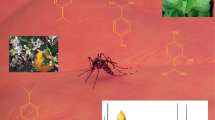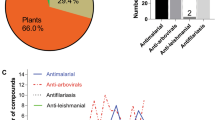Abstract
Arthropods, particularly insects, are endowed with the richest chemical diversity which needs to be harnessed. Arthropods are reservoirs of neurotoxins, peptides, terpenoids, saponins, sugars, etc., that have the potential to cure modern human ailments like HIV, dengue, chikungunya, Ebola virus, Japanese encephalitis, and other syndromes. Basic knowledge of chemical interactions among and between organisms is important to understand the nature of disease treatment, controlling pest and food production, to name a few examples. In order to achieve improved livelihoods, it is necessary to use the chemistry of nature and to use it in a sustainable manner. Isolation, characterization of the molecule, and mass production need a holistic understanding of the chemical and physical properties of the substances arthropods produce. Pharmacognosy is still naive and needs to be further explored.
Access this chapter
Tax calculation will be finalised at checkout
Purchases are for personal use only
Similar content being viewed by others
References
Aaron TD (2010) Insects and their chemical weaponry: new potential for drug discovery. Nat Prod Rep 27:1737–1757
Baghian A, Jaynes J, Enright F, Kousoulas KG (1997) An amphipathic α-helical synthetic peptide analogue of melittin inhibits herpes simplex virus-1 (HSV-1)-induced cell fusion and virus spread. Peptides 18(2):177–183
Basson NJ, Grobler SR (2008) Antimicrobial activity of two South African honeys produced from indigenous Leucospermum cordifolium and Erica species on selected micro-organisms. BMC Complement Altern Med 8:41–67
Butenandt A, Beckmann R, Stamn D, Hecker E (1959) Uber den Sexuallockstoff des seidenspinners Bombyx mori. Reindarstellung und Konstitution. Z Naturforsch 14b:283–284
Cherniack EP, Cherniack EP (2011) Bugs as drugs, part two: worms, leeches, scorpions, snails, ticks, centipedes, and spiders. Altern Med Rev 16:50–58
Costa-Neto EM (2005) Entomotherapy or the medicinal use of insects. J Ethnobiol 25(1):93–114
Dimarcq JL, Hunneyball (2003) Pharma-entomology: when bugs become drugs. Drug Discov Today 8(3):107–110
Dorn DC, Kou CA, Png KJ, Moore MA (2009) The effect of cantharidins on leukemic stem cells. Int J Cancer 124:2186–2199
Efem SE, Udoh KT, Iwara CI (1992) The antimicrobial spectrum of honey and its clinical significance. Infection 20(4):227–229
Estrada G, Villegas E, Corzo (2007) Spider venoms: a rich source of acylpolyamines and peptides as new leads for CNS drugs. Nat Prod Rep 24(1):145–161
Fox JW, Serrano SMT (2007) Approaching the golden age of natural product pharmaceuticals from venom libraries: an overview of toxins and toxin-derivatives currently involved in therapeutic or diagnostic applications. Curr Pharm Des 13(28):2927–2934
Fujiwara Y, Mangetsu M, Yang P, Kofujita H, Suzuki K, Ohfune Y, Shinada T (2008) A quinone isolated from the nest of Vespa simillima and its growth inhibitory effect on rat liver cancer cell. Biol Pharm Bull 31(4):722–725
Han J, Inoue S, Isoda H (2007) Effects of silkworm powder on glucose absorption by human intestinal epithelial cell line Caco-2. J Nat Med 1(4):387–390
Horobin AJ, Shakesheff KM, Woodrow S, Pritchard DI (2003) Maggots and wound healing: an investigation of the effects of secretions from Lucilia sericata larvae upon interactions between human dermal fibroblasts and extracellular matrix components. Br J Dermatol 148:923–933
King GF, Hardy MC (2013) Spider-venom peptides: structure, pharmacology, and potential for control of insect pests. Annu Rev Entomol 58:475–496
Konno K, Ono H, Nakamura M, Tateishi K, Hirayama C, Tamura Y, Hattori M, Koyama A, Kohno K (2006) Mulberry latex rich in antidiabetic sugar-mimic alkaloids forces dieting on caterpillars. Proc Natl Acad Sci U S A 103(5):1337–1341
Laurent P, Braekman JC, Daloze D (2005) Insect chemical defense. Top Curr Chem 240:167229
Leem JY, Nishimura C, Kurata S, Shimada I, Kobayashi A, Natori S (1996) Purification and characterization of N-b-Alanyl-5-S-glutathionyl-3,4-dihydroxyphenylalanine, a novel antibacterial substance of Sarcophaga peregrina (flesh fly). J Biol Chem 271(23):13573–13577
Leung R, Ho A, Chan J, Choy D, Lai CK (1997) Royal jelly consumption and hypersensitivity in the community. Clin Exp Allergy 27:333–336
Liu D, Chen Z (2009) The effects of cantharidin and cantharidin derivates on tumour cells. Anticancer Agents Med Chem 9:392–396
Matanic VCA, Castilla V (2004) Antiviral activity of antimicrobial cationic peptides against Junin virus and herpes simplex virus. Int J Antimicrob Agents 23(4):382–389
Meda A, Lamien CE, Millogo J, Romito M, Nacoulma OG (2004) Therapeutic uses of honey and honey- bee larvae in central Burkina Faso. J Ethnopharmacol 95:103–107
Meylaers K, Clynen E, Daloze D, DeLoof A, Schoofs L (2004) Identification of 1-lysophosphatidylethanolamine (C(16:1)) as an antimicrobial compound in the housefly, Musca domestica. Insect Biochem Mol Biol 34(1):43–49
Miyata T (2007) Pharmacological basis of traditional medicines and health supplements as curatives. J Pharmacol Sci 103:127–131
Moed L, Shwayder TA, Chang MW (2001) Cantharidin revisited: a blistering defense of an ancient medicine. Arch Dermatol 137:1357–1360
Namba T, Ma YH, Inagaki K (1988) Insect-derived crude drugs in the Chinese Song dynasty. J Ethnopharmacol 24(2–3):247–285
Noda N, Umebayashi K, Nakatani T, Miyahara K, Ishiyama K (2005) Isolation and characterization of some hydroxy fatty and phosphoric acid esters of 10-hydroxy-2-decenoic acid from the royal jelly of honeybees (Apis mellifera). Lipids 40(8):833–838
Oldfield ML (1984) The value of conserving genetic resources. U.S Department of the Interior National Park Service, Washington, DC
Oldfield ML (1989) The value of conserving genetic resources. Sinauer Associates, Sunderland, pp 379
Opletalová K, Blaizot X, Mourgeon B (2012) Maggot therapy for wound debridement: a randomized multicenter trial. Arch Dermatol 148(4):432–438
Pavan M, Bo G (1953) Pederin, toxic principles obtained in the crystalline state from the beetle Paederus fuscipes Curt. Physiol Comp Oecologia 3:307–312
Pettit GR (1977) Biosynthetic products for cancer chemotherapy. Springer US, Boston. ISBN 978-1-4684-7232-5
Pettit GR, Sengupta D, Herald CL, Sharkey NA, Blumberg PM (1991) Synthetic conversion of bryostatin 2 to bryostatin 1 and related bryopyrans. Can J Chem 69:856–860
Pimenta AMC, de Lima ME (2005) Small peptides, big world: biotechnological potential in neglected bioactive peptides from arthropod venoms. J Pept Sci 11:670–676
Ramos-Elorduy C, Moreno Pino JM (1988) The utilization of insects in the empirical medicine of ancient. Mex J Ethnobiol 8(2):195–202
Ramos-Elorduy J, Motte-Florae E, Pino JM, Andary C (1999) Les insectesutilisesen medicine traditionnelle au Mexique: Perspectives. In Healing: yesterday today and tomorrow (CD ROM). Erga Ediziones, Geneva, pp 271–290
Rauh R, Kahl S, Boechzelt H, Bauer R, Kaina B, Efferth T (2007) Molecular biology of cantharidin in cancer cells. Chin Med 2:8–14
Schroeder FC, Taggi AE, Gronquist M, Malik RU, Grant JB, Eisner T, Meinwald J (2008) NMR-spectroscopic screening of spider venom reveals sulfated nucleosides as major components for the brown recluse and related species. Proc Natl Acad Sci U S A 105(38):14283–14287
Schwartz EF, Mourão CB, Moreira KG, Camargos TS, Mortari MR (2012) Arthropod venoms: a vast arsenal of insecticidal neuropeptides. Biopolymers 98:385–405
Suzuki KM, Isohama Y, Maruyama H, Yamada Y, Narita Y, Ohta S, Araki Y, Miyata T, Mishima S (2008) Estrogenic activities of fatty acids and a sterol isolated from royal jelly. Evid Based Complement Alternat Med 5:295–302
Wang XH, Andrae L, Engeseth NJ (2002) Antimutagenic effect of various honeys and sugars against Trp-p-1. J Agric Food Chem 50:6923–6928
Wolff H, Hansson C (2003) Larval therapy – an effective method of ulcer debridement. Clin Exp Dermatol 28:134–137
Yoo YC, Shin BH, Hong JH, Lee, Chee HY, Song KS, Lee KB (2007) Isolation of fatty acids with anticancer activity from Protaetia brevitarsis larva. Arch Pharm Res 30(3):361–365
Author information
Authors and Affiliations
Corresponding author
Editor information
Editors and Affiliations
Rights and permissions
Copyright information
© 2016 Springer Science+Business Media Singapore
About this chapter
Cite this chapter
Anudita, Varunrajan, V., Deepa, B.M. (2016). Prospecting Arthropod Biomolecules for Medicinal and Therapeutic Use: Recent Breakthroughs. In: Chakravarthy, A., Sridhara, S. (eds) Arthropod Diversity and Conservation in the Tropics and Sub-tropics. Springer, Singapore. https://doi.org/10.1007/978-981-10-1518-2_2
Download citation
DOI: https://doi.org/10.1007/978-981-10-1518-2_2
Published:
Publisher Name: Springer, Singapore
Print ISBN: 978-981-10-1517-5
Online ISBN: 978-981-10-1518-2
eBook Packages: Biomedical and Life SciencesBiomedical and Life Sciences (R0)




